
Economy of Senegal
Encyclopedia
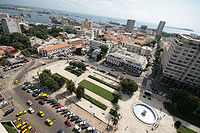


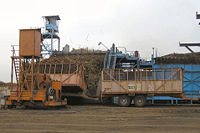
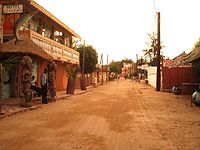
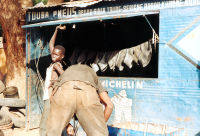
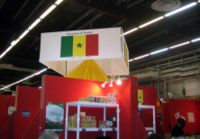
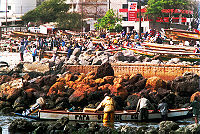
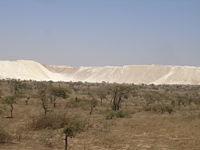
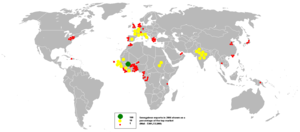
Commercial fishing
Commercial fishing is the activity of catching fish and other seafood for commercial profit, mostly from wild fisheries. It provides a large quantity of food to many countries around the world, but those who practice it as an industry must often pursue fish far into the ocean under adverse conditions...
, phosphates, groundnut
Peanut
The peanut, or groundnut , is a species in the legume or "bean" family , so it is not a nut. The peanut was probably first cultivated in the valleys of Peru. It is an annual herbaceous plant growing tall...
s, tourism, and services. Its agricultural
Agriculture
Agriculture is the cultivation of animals, plants, fungi and other life forms for food, fiber, and other products used to sustain life. Agriculture was the key implement in the rise of sedentary human civilization, whereby farming of domesticated species created food surpluses that nurtured the...
sector is highly vulnerable to variations in rainfall and changes in world commodity
Commodity markets
Commodity markets are markets where raw or primary products are exchanged. These raw commodities are traded on regulated commodities exchanges, in which they are bought and sold in standardized contracts....
prices. Dakar
Dakar
Dakar is the capital city and largest city of Senegal. It is located on the Cap-Vert Peninsula on the Atlantic coast and is the westernmost city on the African mainland...
, as the former capital of French West Africa
French West Africa
French West Africa was a federation of eight French colonial territories in Africa: Mauritania, Senegal, French Sudan , French Guinea , Côte d'Ivoire , Upper Volta , Dahomey and Niger...
, is also home to banks and other institutions which serve all of Francophone West Africa, and is a hub for shipping and transport in the region. It also boasts one of the best developed tourist industries in Africa. Senegal still depends heavily on foreign assistance, which in 2000 represented about 32% of overall government spending—including both current expenditures and capital investments—or CFA
West African CFA franc
The West African CFA franc is the currency of eight independent states in West Africa: Benin, Burkina Faso, Côte d'Ivoire, Guinea-Bissau, Mali, Niger, Sénégal and Togo. The acronym CFA stands for Communauté financière d'Afrique...
270.8 billion (U.S.$ 361.0 million). Senegal is a member of the World Trade Organization
World Trade Organization
The World Trade Organization is an organization that intends to supervise and liberalize international trade. The organization officially commenced on January 1, 1995 under the Marrakech Agreement, replacing the General Agreement on Tariffs and Trade , which commenced in 1948...
.
History
The GDP per capita of Senegal shrank by 1.30% in the 60s. However, it registered a peak growth of 158% in the 70s, and still expanded 43% in the turbulent 1980s. However, this proved unsustainable and the economy consequently shrank by 40% in the 90s.IMF and 1990s economic reforms
Since the January 1994 CFA franc devaluation, the International Monetary FundInternational Monetary Fund
The International Monetary Fund is an organization of 187 countries, working to foster global monetary cooperation, secure financial stability, facilitate international trade, promote high employment and sustainable economic growth, and reduce poverty around the world...
(IMF), the World Bank
World Bank
The World Bank is an international financial institution that provides loans to developing countries for capital programmes.The World Bank's official goal is the reduction of poverty...
, and other multilateral and creditors have been supporting the Government of Senegal’s structural and sectoral adjustment programs. The broad objectives of the program have been to facilitate growth and development by reducing the role of government in the economy, improving public sector management, enhancing incentives for the private sector, and reducing poverty.
In January 1994, Senegal
Senegal
Senegal , officially the Republic of Senegal , is a country in western Africa. It owes its name to the Sénégal River that borders it to the east and north...
undertook a bold and ambitious economic reform program with the support of the international donor community. This reform began with a 50% devaluation of Senegal's currency, the CFA franc, which was linked at a fixed rate to the French franc
French franc
The franc was a currency of France. Along with the Spanish peseta, it was also a de facto currency used in Andorra . Between 1360 and 1641, it was the name of coins worth 1 livre tournois and it remained in common parlance as a term for this amount of money...
. Government price controls and subsidies have been steadily dismantled as another economic reform. However, this devaluation had severe social consequences, because most of the essentials goods were imported. Overnight, the price of goods such as milk, rice, fertilizer and machinery doubled. As a result, the country suffered a large exodus, with many of the most educated people and those who could afford it choosing to leave the country. After an economic contraction of 2.1% in 1993, Senegal made an important turnaround, thanks to the reform program, with a growth in GDP averaging over 5% annually during 1995-2004. Annual inflation
Inflation
In economics, inflation is a rise in the general level of prices of goods and services in an economy over a period of time.When the general price level rises, each unit of currency buys fewer goods and services. Consequently, inflation also reflects an erosion in the purchasing power of money – a...
had been pushed down to the low single digits. As a member of the West African Economic and Monetary Union (WAEMU), Senegal is working toward greater regional integration with a unified external tariff and a more stable monetary policy. Senegal still relies heavily upon outside donor assistance, however. Under the IMF's Highly Indebted Poor Countries debt relief program, Senegal will benefit from eradication of two-thirds of its bilateral, multilateral, and private sector debt, contingent on the completion of privatization program proposed by the government and approved by the IMF.
External trade and investment
The fishingCommercial fishing
Commercial fishing is the activity of catching fish and other seafood for commercial profit, mostly from wild fisheries. It provides a large quantity of food to many countries around the world, but those who practice it as an industry must often pursue fish far into the ocean under adverse conditions...
sector has replaced the groundnut
Peanut
The peanut, or groundnut , is a species in the legume or "bean" family , so it is not a nut. The peanut was probably first cultivated in the valleys of Peru. It is an annual herbaceous plant growing tall...
sector as Senegal's export leader. Its export earnings reached U.S.$239 million in 2000. The industrial fishing operations struggle with high costs, and Senegalese tuna
Tuna
Tuna is a salt water fish from the family Scombridae, mostly in the genus Thunnus. Tuna are fast swimmers, and some species are capable of speeds of . Unlike most fish, which have white flesh, the muscle tissue of tuna ranges from pink to dark red. The red coloration derives from myoglobin, an...
is rapidly losing the French market to more efficient Asian competitors.
Phosphate production, the second major foreign exchange earner, has been steady at about U.S.$95 million. Exports of peanut products reached U.S.$79 million in 2000 and represented 11% of total export earnings. Receipts from tourism, the fourth major foreign exchange earner, have picked up since the January 1994 devaluation. In 2000, some 500,000 tourists visited Senegal, earning the country $120 million.
Senegal’s new Agency for the Promotion of Investment (APIX) plays a pivotal role in the government’s foreign investment program. Its objective is to increase the investment rate from its current level of 20.6% to 30%. Currently, there are no restrictions on the transfer or repatriation of capital and income earned, or investment financed with convertible foreign exchange. Direct U.S. investment in Senegal remains about U.S.$38 million, mainly in petroleum marketing, pharmaceuticals manufacturing, chemicals, and banking. Economic assistance, about U.S.$350 million a year, comes largely from France
France
The French Republic , The French Republic , The French Republic , (commonly known as France , is a unitary semi-presidential republic in Western Europe with several overseas territories and islands located on other continents and in the Indian, Pacific, and Atlantic oceans. Metropolitan France...
, the IMF, the World Bank, and the United States
United States
The United States of America is a federal constitutional republic comprising fifty states and a federal district...
. Canada
Canada
Canada is a North American country consisting of ten provinces and three territories. Located in the northern part of the continent, it extends from the Atlantic Ocean in the east to the Pacific Ocean in the west, and northward into the Arctic Ocean...
, Italy
Italy
Italy , officially the Italian Republic languages]] under the European Charter for Regional or Minority Languages. In each of these, Italy's official name is as follows:;;;;;;;;), is a unitary parliamentary republic in South-Central Europe. To the north it borders France, Switzerland, Austria and...
, Japan
Japan
Japan is an island nation in East Asia. Located in the Pacific Ocean, it lies to the east of the Sea of Japan, China, North Korea, South Korea and Russia, stretching from the Sea of Okhotsk in the north to the East China Sea and Taiwan in the south...
, and Germany
Germany
Germany , officially the Federal Republic of Germany , is a federal parliamentary republic in Europe. The country consists of 16 states while the capital and largest city is Berlin. Germany covers an area of 357,021 km2 and has a largely temperate seasonal climate...
also provide assistance.
Senegal has well-developed though costly port facilities, a major international airport serving 23 international airlines, and direct and expanding telecommunications links with major world centers.
Indebtedness
With an external debt of U.S.$2,495 million, and with its economic reform program on track, Senegal qualified for the multilateral debt reliefDebt relief
Debt relief is the partial or total forgiveness of debt, or the slowing or stopping of debt growth, owed by individuals, corporations, or nations. From antiquity through the 19th century, it refers to domestic debts, in particular agricultural debts and freeing of debt slaves...
initiative for Heavily Indebted Poor Countries
Heavily Indebted Poor Countries
Heavily Indebted Poor Countries is a group of 40 developing countries with high levels of poverty and debt overhang which are eligible for special assistance from the International Monetary Fund and the World Bank.- History and structure :...
(HIPC). Progress on structural reforms is on track, but the pace of reforms remains slow, as delays occur in implementing a number of measures on the privatization program, good governance
Good governance
Good governance is an indeterminate term used in development literature to describe how public institutions conduct public affairs and manage public resources in order to guarantee the realization of human rights. Governance describes "the process of decision-making and the process by which...
issues, and the promotion of private sector activity. However, macroeconomic indicators show that Senegal turned in a respectable performance in meeting IMF targets in 2000: annual GDP growth increased to 5.7%, compared to 5.1% in 1999. Inflation was reported to be 0.7% compared to 0.8% in 1999, and the current account deficit (excluding transfers) was held at less than 6% of GDP.
Notable Senegalese companies
Large Senegalese companies include SenelecSenelec
Senelec is the national electricity company of Senegal.-History:Senelec was established in 1983 after the nationalization and merger of Électricité du Sénégal and Société sénégalaise de distribution d'électricité...
, the national power company; Air Sénégal International
Air Senegal International
Air Sénégal International was an airline with its head office in Dakar, Senegal. It was a regional carrier operating a scheduled domestic network and regional flights to neighbouring countries. It also operated charter and air taxi flights...
airlines; Sonatel
Sonatel
Sonatel is the principal telecommunications provider of Senegal. The company is active in fixed line telephony, mobile telephony, internet service, television and corporate telecommunications...
, the principal telecommunications provider in Senegal; and Industrie chimique du Sénégal, a chemical processing company.
Trade unions
Senegalese trade unions include The National Confederation of Senegalese Workers (CNTS) and it's affiliate the Dakar Dem Dikk Workers Democratic UnionDakar Dem Dikk Workers Democratic Union
Dakar Dem Dikk Workers Democratic Union is a trade union of employees of Dakar Dem Dikk . The general secretary of UDT-3D is Mamadou Goudiaby, another important leader and negotiator of the union is Christian Salvy. UDT-3D is affiliated to CNTS/FC....
(Dakar Public Transport workers), The
Democratic Union of Senegalese Workers (UTDS), The General Confederation Of Democratic Workers Of Senegal (CGTDS) and the National Union of Autonomous Trade Unions of Senegal (UNSAS). Mean wages were $0.99 per manhour in 2009.
Stock exchange
Senegal's corporations are included in the Bourse Régionale des Valeurs Mobilières SABRVM
The Bourse Régionale des Valeurs Mobilières SA or BRVM, is a regional stock exchange serving the following west African countries: Benin Burkina Faso Guinea Bissau Côte d'Ivoire Mali Niger Senegal Togo....
(BRVM), a regional stock exchange
Stock exchange
A stock exchange is an entity that provides services for stock brokers and traders to trade stocks, bonds, and other securities. Stock exchanges also provide facilities for issue and redemption of securities and other financial instruments, and capital events including the payment of income and...
serving the following eight West African countries, and located in Abidjan, Cote d'Ivoire.
Regional and International economic groupings
- Organization of African Unity (OAU)/Africa Union
- The Franc Zone
- The Lomé ConventionLomé ConventionThe Lomé Convention is a trade and aid agreement between the European Community and 71 African, Caribbean, and Pacific countries, first signed in February 1975 in Lomé, Togo.- History :...
- Economic Community of West African StatesEconomic Community of West African StatesThe Economic Community of West African States is a regional group of fifteen West African countries. Founded on 28 May 1975, with the signing of the Treaty of Lagos, its mission is to promote economic integration across the region....
(ECOWAS) - Union économique et monétaire Ouest Africaine (UEMOAUEMOAUEMOA may refer to:*UEMOA Tournament - Annual International Football tournament*West African Economic and Monetary Union...
) - The African Groundnut CouncilAfrican Groundnut CouncilThe African Groundnut Council is a state-level organization designed to promote groundnuts produced in the countries of The Gambia, Mali, Niger, Senegal, the Sudan and Nigeria.-History:...
- the Organisation pour la mise en valeur du fleuve SénégalOrganisation pour la mise en valeur du fleuve SénégalThe Organisation pour la mise en valeur du fleuve Sénégal is an organisation of Guinea, Mali, Mauritania and Senegal to manage the Senegal River and its drainage basin....
Statistics
- GDP (purchasing power parity
U.S.$21.13 billion (2008 est.)
- GDP (official exchange rate
U.S.$11.12 billion (2007 est.)
- GDP - real growth rat
4.6% (2007 est.)
- GDP - per capita (PPP
U.S.$1,700 (2007 est.)
- GDP - composition by secto
agriculture: 16% industry: 19.4% services: 64.6% (2007 est.)
- Population below poverty lin
43,4% (2010 est.)
- Household income or consumption by percentage shar
lowest 10%: 2.7% highest 10%: 33.4% (2007)
- Inflation rate (consumer prices
5.4% (2008 est.)
- Investment (gross fixed
41% of GDP (2006 est.)
- Labor forc
4.876 million (2009 est.)
- Labor force - by occupatio
agriculture: 75% industry and services: 25% (1990 est.)
- Unemployment rat
48%; note - urban youth 40% (2001 est.)
- Distribution of family income - ini index]
40 (2005)
- Budge
- ;revenues
- U.S.$2.023 billio
- ;expenditures
- U.S.$2.377 billion; including capital expenditures of $357 million (2006 est.
- Public deb
22.5% of GDP (2007 est.)
- Industrie
agricultural and fish processing, phosphate mining, fertilizer production, petroleum refining, construction materials, ship construction and repair
- Industrial production growth rat
5.2% (2007 est.)
- Electricity - productio
2.159 billion kWh (2007)
- Electricity - consumptio
1.859 billion kWh (2007)
- Electricity - export
0 kWh (2004)
- Electricity - import
0 kWh (2004)
- Oil - productio
0 oilbbl/d (2004 est.)
- Oil - consumptio
35000 oilbbl/d (2007 est.)
- Natural gas - productio
50 million cu m (2005 est.)
- Natural gas - consumptio
50 million cu m (2004 est.)
- Natural gas - export
0 cu m (2004 est.)
- Natural gas - import
0 cu m (2004 est.)
- Current Account Balanc
U.S.-$1.458 billion (2007 est.)
- Agriculture - product
peanuts, millet, maize, sorghum, rice, cotton, tomatoes, green vegetables; cattle, poultry, pigs; fish
- Export
U.S.$1.65 billion f.o.b. (2007 est.)
- Exports - commoditie
fish, groundnuts (peanuts), petroleum products, phosphates, cotton
- Exports - partner
Mali
Economy of Mali
The Economy of Mali is based to a large extent on agriculture, with an overwhelmingly rural population, many of whom are engaged in subsistence agriculture...
18.4%, France
Economy of France
France is the world's fifth largest economy by nominal figures and the ninth largest economy by PPP figures. It is the second largest economy in Europe in nominal figures and third largest economy in Europe in PPP figures...
8.9%, Italy
Economy of Italy
Italy has a diversified industrial economy with high gross domestic product per capita and developed infrastructure. According to the International Monetary Fund, the World Bank and the CIA World Factbook, in 2010 Italy was the seventh-largest economy in the world and the third-largest in Europe...
5.8%, India
Economy of India
The Economy of India is the ninth largest in the world by nominal GDP and the fourth largest by purchasing power parity . The country is a part of the G-20 major economies and the BRICS, in addition to being partners of the ASEAN. India has a per capita GDP of $3,608 as per 2010 figures, making it...
5.6% The Gambia
Economy of the Gambia
The Gambia has no important mineral or other natural resources and has a limited agricultural base. About 75% of the population depends on crops and livestock for its livelihood. Small-scale manufacturing activity features the processing of peanuts, fish, and hides...
5.1% (2007 est)
- Import
U.S.$3.650 billion f.o.b. (2010 est.)
- Imports - commoditie
food and beverages, capital goods, fuels
- Imports - partner
France 22.2%, Netherlands
Economy of the Netherlands
On the Index of Economic Freedom, the Netherlands is the 13th most laissez-faire capitalist economy out of 157 surveyed countries. At the time of writing the Netherlands is the 16th largest economy of the world. Between 1998 and 2000 annual economic growth averaged nearly 4%, well above the...
9.6%, PR of China
Economy of the People's Republic of China
The People's Republic of China ranks since 2010 as the world's second largest economy after the United States. It has been the world's fastest-growing major economy, with consistent growth rates of around 10% over the past 30 years. China is also the largest exporter and second largest importer of...
7.4%, Thailand
Economy of Thailand
The economy of Thailand is a newly industrialized economy. It is a heavily export-dependent economy, with exports accounting for more than two thirds of gross domestic product ....
5.2%, Belgium
Economy of Belgium
The modern, private enterprise economy of Belgium has capitalised on its central geographic location, highly developed transport network, and diversified industrial and commercial base...
4.5% (2007)
- Reserves of foreign exchange and gol
U.S.$1.18 billion (2006 est.)
- Debt - externa
U.S.$1.88 billion (2010 est.)
- Economic aid - recipien
U.S.$449.6 million (2003 est.)
- Currency (code
Communaute Financiere Africaine franc
West African CFA franc
The West African CFA franc is the currency of eight independent states in West Africa: Benin, Burkina Faso, Côte d'Ivoire, Guinea-Bissau, Mali, Niger, Sénégal and Togo. The acronym CFA stands for Communauté financière d'Afrique...
(XOF); note - responsible authority is the Central Bank of West African States
Central Bank of West African States
The Central Bank of West African States is a central bank serving the eight west African countries which comprise the West African Economic and Monetary Union:*Benin*Burkina Faso*Cote d'Ivoire*Guinea Bissau*Mali*Niger*Senegal*Togo-See also:...
- Exchange rate
Communaute Financiere Africaine francs (XOF) per US dollar - 522.89 (2006), 527.47 (2005), 528.29 (2004), 581.2 (2003), 696.99 (2002).
In 2006, 1 € = 655.82 XOF (West-African CFA), or 1 XOF = 0.001525 € / € to XOF / XOF to €
- Fiscal yea
calendar year
Macro-economic trends
This is a chart of trend of gross domestic product of Senegal at market prices estimated by the International Monetary FundInternational Monetary Fund
The International Monetary Fund is an organization of 187 countries, working to foster global monetary cooperation, secure financial stability, facilitate international trade, promote high employment and sustainable economic growth, and reduce poverty around the world...
with figures in millions of CFA Francs.
| Year | Gross Domestic Product | US Dollar Exchange | Inflation Index (2000=100) |
|---|---|---|---|
| 1980 | 652,221 | 211.27 CFA Francs | ? |
| 1985 | 1,197,462 | 449.32 CFA Francs | 66 |
| 1990 | 1,603,679 | 272.27 CFA Francs | 66 |
| 1995 | 2,309,091 | 499.15 CFA Francs | 93 |
| 2000 | 3,192,019 | 709.96 CFA Francs | 100 |
| 2005 | 4,387,230 | 526.55 CFA Francs | 107 |
Average wages in 2007 hover around $4–5 per day.
See also
- SenegalSenegalSenegal , officially the Republic of Senegal , is a country in western Africa. It owes its name to the Sénégal River that borders it to the east and north...
- Tourism in SenegalTourism in SenegalTourism in Senegal is a vital part of this West African nation's economy.-Scale:From a relatively small industry at the introduction of the first Club Med resort in the 1970s, Tourism has grown to be an important part of the Senegales economy...
- Agriculture in SenegalAgriculture in SenegalMost of Senegal lies within the drought-prone Sahel region, with irregular rainfall and generally poor soils. With only about 5 percent of the land irrigated, Senegal continues to rely on rain-fed agriculture, which occupies about 75 percent of the workforce. Despite a relatively wide variety of...
- Communications in SenegalCommunications in SenegalSenegal has an excellent telecommunications infrastructure, which is digitized. Sonatel, Senegal’s main telecommunications operator, continues to dominate the market. It was privatized in 1997 with France Telecom as the strategic partner. Liberalization of some services accompanied privatization...
- Transport in SenegalTransport in Senegal- Railways :total: 906 kmnarrow gauge: 906 km of gauge - Maps :* * - Ground transport :There were an estimated 4,271 km of paved roads and 10,305 km of unpaved roads as of 1996....
- List of universities in Senegal
- Economy of AfricaEconomy of AfricaThe economy of Africa consists of the trade, industry, and resources of the people of Africa. , approximately 922 million people were living in 54 different countries. Africa is by far the world's poorest inhabited continent...
- CFA francCFA francThe CFA franc is the name of two currencies used in Africa which are guaranteed by the French treasury. The two CFA franc currencies are the West African CFA franc and the Central African CFA franc...
External links
Official Website: Republique du Senegal: MINISTÈRE DE L'ECONOMIE ET DES FINANCES. Annuaire des services administratifs, Republique du Senegal: MINISTÈRE DE L'ECONOMIE ET DES FINANCES.- SENEGAL: CHINESE GOODS STIMULATE INFORMAL TRADING ECONOMY. Interpress Service, Publication Date: 28-AUG-07.
- François Boye. A Retrospective Analysis of the Senegalese Economy, December 1990: Conference paper from School of Business, Montclair State University.
- Senegal latest trade data on ITC Trade Map
- The Senegalese Country Commercial GuideCountry commercial guidesThe Country Commercial Guides are reports, prepared by United States Commercial Service offices around the world, which provide comprehensive commercial information for U.S. companies looking to do business in a specific country....
, published by the United States government to aid the export of US products to foreign markets, can be found at: Senegalese Country Commercial Guides. - Wages of Senegalese workers
- Institute for Security Studies Senegal Economic Summary, 2001.
- Senegal Commerce Business and Trading: Republic of Senegal. (/)
- Senegal: Economy. Aggregated press articles at OneWorldAfrica
- African Studies, Columbia University: Senegal, Banking and investment information.
- West African Agricultural Market Observer/Observatoire du Marché Agricole (RESIMAO), a project of the West-African Market Information Network (WAMIS-NET), provides live market and commodity prices from fifty seven regional and local public agricultural markets across Benin, Burkina Faso, Côte d'Ivoire, Guinea, Niger, Mali, Senegal, Togo, and Nigeria. Sixty commodities are tracked weekly. The project is run by the Benin Ministry of Agriculture, and a number of European, African, and United Nations agencies.
Published works
- Amadou Sakho. Senegal's slide from "model economy" to "least developed country". Misanet.com / IPS (2001).
- Birahim Bouna Niang. A diagnosis of Senegal's public external debt, Provisional report. Republic of Senegal Ministry of Economy and Finance, Political Economy Unit (UPE). January 2003.
- Pamela Cox. The Political Economy of Underdevelopment: Dependence in Senegal. African Affairs, Volume 79, Number 317. Pp. 603-605
- Maghan Keita. The Political Economy of Health Care in Senegal, Journal of Asian and African Studies, Vol. 31, No. 3-4, 145-161 (1996)
- John Waterbury and Mark Gersovitz, eds., The political economy of risk and choice in Senegal.Frank Cass & Co. Ltd, London, (1987) ISBN 0-7146-3297X
- Christopher L. Delgado, Sidi Jammeh. The Political Economy of Senegal Under Structural Adjustment. School of Advanced International Studies, Johns Hopkins University (1991). ISBN 0-275-93525-6
- Cathy L. Jabara, Robert L. Thompson. Agricultural Comparative Advantage under International Price Uncertainty: The Case of Senegal. American Journal of Agricultural EconomicsAmerican Journal of Agricultural EconomicsThe American Journal of Agricultural Economics is a peer-reviewed academic journal of agricultural, natural resource, and environmental economics, as well as rural and community development. Published five times per year, it is one of two journals published by the Agricultural & Applied Economics...
, Vol. 62, No. 2 (May, 1980), pp. 188-198 - Peter Mark. Urban Migration, Cash Cropping, and Calamity: The Spread of Islam among the Diola of Boulouf (Senegal), 1900-1940. African Studies Review, Vol. 21, No. 2 (Sep., 1978), pp. 1-14
- Monique Lakroum. Le Travail Inegal: Paysans et Salaries Senegalais Face à la Crise des Annees Trente. Paris (1982).
- Ibrahima Thioub, Momar-Coumba Diop, Catherine Boone. Economic Liberalization in Senegal: Shifting Politics of Indigenous Business Interests. African Studies Review, Vol. 41, No. 2 (Sep., 1998), pp. 63-89
- Catherine Boone. Merchant Capital and the Roots of State Power in Senegal, 1930-1985, McGill, (1995). Jean Copans, Philippe Couty, Jean Roch, G. Rocheteau. Maintenance sociale et changement economique au Senegal I: Doctrine economique et pratique du travail chez les Mourides. Paris (1974).

